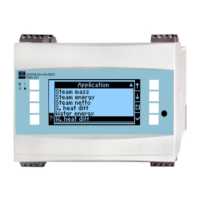RMS621 Appendix
Endress+Hauser 69
The flow is calculated as follows:
ƒ = correction factor (K-factor or value from the correction table)
d = internal diameter
∆P = differential pressure
ρ = density in operating status
Example:
Flow measurement in a steam line with a Deltatop Pitot tube
• Internal diameter: 350 mm
• k-factor (correction factor for the resistance coefficient of the probe): 0.634
• Working range ∆P: 0 - 51, 0 mbar (Q: 0-15000 m
3
/h)
Notes on the configuration:
•Flow Æ Flow 1; Diff.pressure Æ Pitot; Signal Æ 4...20 mA; Æ Range start/range end (mbar);
Pipe dataÆ Inner dia. 350 mm; Æ Factor 0.634.
Flow measurement with V cone transmitter
The following data are needed when using V-cone flow transmitters:
• Internal diameter
• Diameter ratio β
• Flow coefficient c
The flow coefficient can be entered as a fixed value or in the form of a table depending on the
Reynolds number. Please refer to the data sheet of the manufacturer for data regarding this. The
flow is calculated from the input signals differential pressure, temperature and static pressure as per
ISO 5167 (see Improved method). The temperature effect on the V-cone (Fa value) is calculated
automatically when the thermal expansion coefficient of the V-cone is entered (see "Temperature
effect on internal diameter and diameter ratio β" above).
If the data available are insufficient, scale the DP transmitter to volume and use the flow input in
Energy Manager.
General notes on differential pressure measurement
If all the data on the differential pressure measuring point are available (internal pipe diameter, ß or
k-factor), we recommend you use the improved method (fully compensated flow calculation).
If the data required are not available, the output signal of the differential pressure transmitter is
output scaled to volume or mass (see the following table). Please note that a signal scaled to mass
can no longer be compensated. For this reason, scale the DP transmitter to operating volume if
possible (mass: density in design parameter = operating volume). The mass flow is then calculated
in the device based on the density in the operating status, depending on the temperature and
pressure. This is partially compensated flow calculation, since the square root density is in the design
parameter when measuring the operating volume.

